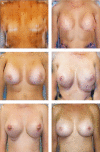BreastGAN: Artificial Intelligence-Enabled Breast Augmentation Simulation
- PMID: 35072073
- PMCID: PMC8781773
- DOI: 10.1093/asjof/ojab052
BreastGAN: Artificial Intelligence-Enabled Breast Augmentation Simulation
Abstract
Background: Managing patient expectations is important to ensuring patient satisfaction in aesthetic medicine. To this end, computer technology developed to photograph, digitize, and manipulate three-dimensional (3D) objects has been applied to the female breast. However, the systems remain complex, physically cumbersome, and extremely expensive.
Objectives: The authors of the current study wish to introduce the plastic surgery community to BreastGAN, a portable, artificial intelligence (AI)-equipped tool trained on real clinical images to simulate breast augmentation outcomes.
Methods: Charts of all patients who underwent bilateral breast augmentation performed by the senior author were retrieved and analyzed. Frontal before and after images were collected from each patient's chart, cropped in a standardized fashion, and used to train a neural network designed to manipulate before images to simulate a surgical result. AI-generated frontal after images were then compared with the real surgical results.
Results: Standardizing the evaluation of surgical results is a timeless challenge which persists in the context of AI-synthesized after images. In this study, AI-generated images were comparable to real surgical results.
Conclusions: This study features a portable, cost-effective neural network trained on real clinical images and designed to simulate surgical results following bilateral breast augmentation. Tools trained on a larger dataset of standardized surgical image pairs will be the subject of future studies.
© 2021 The Aesthetic Society.
Figures



Comment in
-
Commentary on: BreastGAN: Artificial Intelligence-Enabled Breast Augmentation Simulation.Aesthet Surg J Open Forum. 2022 Apr 14;4:ojac028. doi: 10.1093/asjof/ojac028. eCollection 2022. Aesthet Surg J Open Forum. 2022. PMID: 35662904 Free PMC article. No abstract available.
References
-
- Creasman CN, Mordaunt D, Liolios T, Chiu C, Gabriel A, Maxwell GP. Four-dimensional breast imaging, part I: introduction of a technology-driven, evidence-based approach to breast augmentation planning. Aesthet Surg J. 2011;31(8):914-924. - PubMed
-
- Creasman CN, Mordaunt D, Liolios T, Chiu C, Gabriel A, Maxwell GP. Four-dimensional breast imaging, part II: clinical implementation and validation of a computer imaging system for breast augmentation planning. Aesthet Surg J. 2011;31(8):925-938. - PubMed
-
- Adams WP Jr, Mckee D. Matching the implant to the breast: a systematic review of implant size selection systems for breast augmentation. Plast Reconstr Surg. 2016;138(5):987-994. - PubMed
-
- Costa CR, Small KH, Adams WP Jr. Bra sizing and the plastic surgery herd effect: are breast augmentation patients getting accurate information? Aesthet Surg J. 2017;37(4):421-427. - PubMed
LinkOut - more resources
Full Text Sources
